LOCH AWE
Northernmost part of the lake with the ancient Kilchurn Castle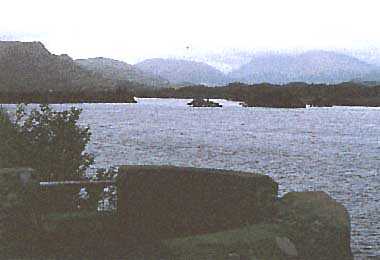 Photo: A. Kurata
Photo: A. Kurata
A. LOCATION
- Scotland, UK.
- 56:20N, 5:10W; 36.2 m above sea level.
B. DESCRIPTION
- Of glacial origin, Loch Awe is the longest lake
in Great Britain with a total length of 41.0 km. It is, however, an extremely
narrow lake, and is in most places only about one kilometer in breadth.
The mean breadth is only 2.3 percent of the length which is the smallest
percentage observed in any of the 562 lakes surveyed until now. The surface
area is 38.5 km2 which means that Loch Awe is the third largest in Great
Britain in this respect. It has a mean depth of 32.0 m, a maximum of 93.6
m and a total volume of 1,230,400,000 m3. Like Loch Lomond there are two
main basins deeper than 30 m - one occupying the northern arm (with two
separate depressions), the other occupying most of the long axis of the
lake from the northern islands south.
The catchment of Loch Awe has a relatively high mean altitude and moderate slopes. Almost 20% of its land is afforested and much of its geology is base- rich.
Same as Loch Lomond and Loch Ness, Loch Awe has been subject to most human interference. The lake is likely to be significantly enriched by the activities of humans in its catchment. But, still now the allochthonous matter content is not high enough to reduce the oxygen content in water to the considerable extent characteristic. In this lake, however, one of the few notable exceptions to the general similarity in chemical content of surface, depth and outflow waters was the summer increase of silicon with depth which was also observed in Loch Ness (1, 2, 4, 10).
C. PHYSICAL DIMENSIONS (1, 2)
| Surface area [km2] | 39 |
| Volume [km3] | 1.2 |
| Maximum depth [m] | 93.6 |
| Mean depth [m] | 32.0 |
| Water level | Regulated |
| Normal range of annual water level fluctuation [m] | 2.7 |
| Length of shoreline [km] | 113.9 |
| Residence time [yr] | 0.7 |
| Catchment area [km2] | 780 |
D. PHYSIOGRAPHIC FEATURES
D1 GEOGRAPHICAL (2)-
Bathymetric map: Fig. EUR-27-01.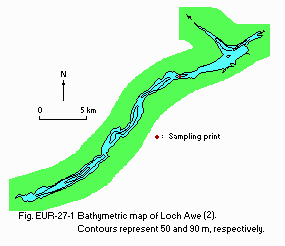
- Names of main islands: The area of island is 0.318 km2.
- Number of outflowing rivers and channels (name): 1 (R. Awe).
- Climatic data at Achnashellach (3)*
| Mean temp. [deg C] | ||||||||||||
| Jan | Feb | Mar | Apr | May | Jun | Jul | Aug | Sep | Oct | Nov | Dec | Ann. |
|---|---|---|---|---|---|---|---|---|---|---|---|---|
| 2.8 | 3.2 | 5.2 | 6.9 | 10.1 | 12.4 | 13.8 | 13.6 | 11.6 | 8.7 | 5.7 | 4.1 | 8.2 |
| Precipitation [mm] | ||||||||||||
| 232 | 177 | 127 | 156 | 93 | 114 | 148 | 150 | 189 | 234 | 196 | 242 | 2,058 |
| * 13-year mean. | ||||||||||||
- Number of hours of bright sunshine: 1,374 hr yr-1.


-
Water temperature: Fig. EUR-27-02.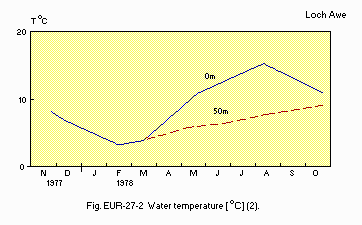


- Freezing period: Occasionally (2).
- Mixing type: Monomictic (2).
E. LAKE WATER QUALITY
E1 TRANSPARENCY [m](6)- November 1977 and October 1978: 2.20-4.20.
| Depth [m] | Jan | Feb | Mar | Apr | May | Jun | Jul | Aug | Sep | Oct | Nov | Dec |
|---|---|---|---|---|---|---|---|---|---|---|---|---|
| 0-10 | - | - | - | - | - | - | - | - | - | - | 6.3 | 7.0 |
| 0-10 | - | 7.1 | 7.0 | - | 6.9 | 6.8 | 6.7 | 6.8 | - | 6.8 | - | - |
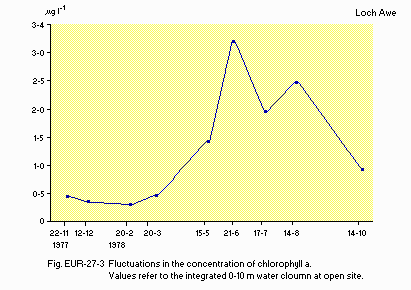


E7 NITROGEN CONCENTRATION:
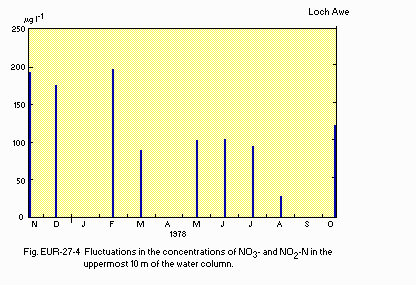


E8 PHOSPHORUS CONCENTRATION (4)
- PO4-P [micro g l-1]
November 1977-October 1978: <10.
F. BIOLOGICAL FEATURES
F1 FLORA- Submerged macrophytes (6)
- Phytoplankton (5)
Carex vesicaria, Equisetum fluviatile, Eleocharis palustris, Juncus fluitans, Nuphar pumila, Lobelia dortmanna, Subularia aquatica, Sparganium minimum, Callitriche hermaphroditica.
Melosira islandica, Rhizosolenia longiseta, Asterionella formosa, Tabellaria fenestrata, T. fenestrata var. asterionelloides, Cryptomonas spp., Rhodomonas minuta, Gymnodinium helveticum, Botryococcus braunii.
- Zooplankton (7)
- Benthos (8)
- Fish (9)
Bosmina coregoni, Polyphemus pediculus, Bythotrephes longimanus, Leptodora kindti, Diaptomus gracilis, Cyclops abyssorum, Diaphanosoma brachyurum, Daphnia hyalina.
Stylaria lacustris, Lumbriculus variegatus, Stylodrilus heringianus, Eurycercus lamellatus, Gammarus lacustris, G. pulex, Centroptilum luteolum, Cloeon simile, Capnia bifrons, Diura bicaudata, Sigata dorsalis.
Salmo salar, S. trutta, Salvelinus alpinus, Esox lucius, Phoxinus phoxinus, Anguilla anguilla, Gasterosteus aculeatus aculeatus, Perca fluviatilis.
-
Zooplankton: Fig. EUR-27-05.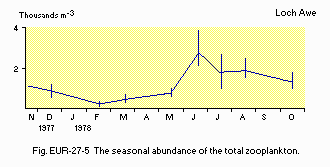


G. SOCIO-ECONOMIC CONDITIONS (1)
G1 LAND USE IN THE CATCHMENT AREA| Area[km2] | [%] | |
|---|---|---|
| - Natural landscape | ||
| Woody vegetation | 152.3 | 19.5 |
| Rough | 596.9 | 76.6 |
| - Agricultural land | 12.5 | 1.6 |
| - Residential area | 2.9 | 0.4 |
| - Others | 14.9 | 1.9 |
| - Total | 779.5 | 100 |
| Population | Population density [km-2] | Major cities (population) | |
|---|---|---|---|
| Total | 777 | 1.0 | None |
H. LAKE UTILIZATION (3, 10)
H1 LAKE UTILIZATION- Source of water and recreation (cruising, sight-seeing, swimming, sport-
fishing).
I. DETERIORATION OF LAKE ENVIRONMENTS AND HAZARDS (4, 10)
I1 ENHANCED SILTATION- Extent of damage: None.
- Present status: Not detected.
- Nuisance caused by eutrophication: None.
- Extent of damage: None.
J. WASTEWATER TREATMENTS (1)
J1 GENERATION OF POLLUTANTS IN THE CATCHMENT AREA- c) Limited pollution with wastewater treatment.
- Municipal wastewater treatment systems
- Industrial wastewater treatment systems
No. of municipal wastewater treatment systems: 2.
No. of industrial wastewater treatment systems: None.
N. SOURCES OF DATA
- Maitland, P. S. (1981) Introduction and catchment analysis. The Ecology of Scotland's Largest Lochs, Lomond, Awe, Ness, Morar and Shiel (ed. Maitland, P. S.), pp. 1-27. Dr. W. Junk Publishers, The Hague.
- Smith, I. R., Lyle, A. A. & Rosie, A. J. (1981) Comparative physical limnology. Ibid., pp. 29-65.
- Muller, M. J. (1982) Selected Climatic Data for a Global Set of Standard Stations for Vegetation Science. 306 pp. Dr. W. Junk Publishers, The Hague.
- Bailley-Watts, A. E. & Duncan, P. (1981) Chemical characterisation: a one-year comparative study. The Ecology of Scotland's Largest Lochs, Lomond, Awe, Ness, Morar and Shiel (see above), pp. 67-89.
- Ibid. (1981) The phytoplankton. Ibid., pp. 91-118.
- Ibid. (1981) A review of macrophyte studies. Ibid., pp. 119-134.
- Maitland, P. S., Smith, B. D. & Dennis, G. M. (1981) The crustacean zooplankton. Ibid., pp. 135-154.
- Smith, B. D., Maitland, P. S., Young, M. R. & Carr, M. J. (1981) The littoral zoobenthos. Ibid., pp. 155-203.
- Maitland, P. S., Smith, B. D. & Adair, S. M. (1981) The fish and fisheries. Ibid., pp. 223-251.
- The editor's observation.


